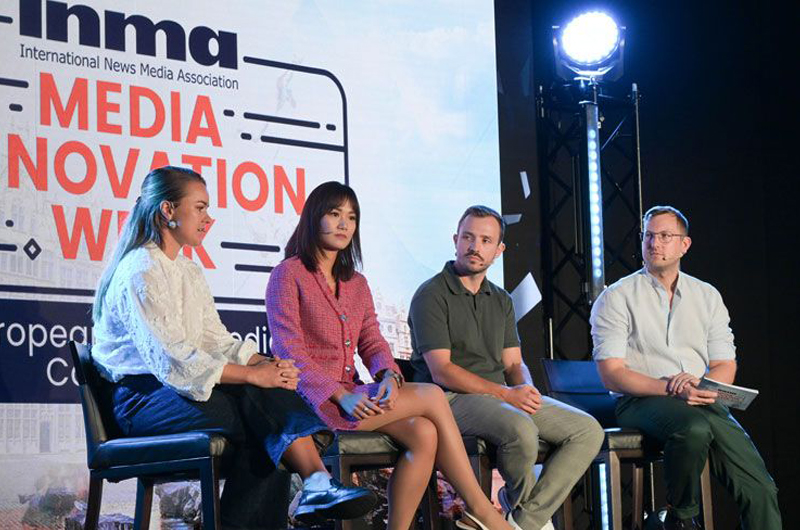The role of younger generations was a hot topic at INMA’s Media Innovation Week in Antwerp, so it made sense to bring together a panel of three young news media leaders to hear their perspectives. Catherine Miller reports
Speaking about the next 12 months, it was clear this generation’s priorities are all about digital. Mari-Marthe Aamold, CEO and CFO for Bergens Tidende and Stavanger Aftenblad (Norway), talked about the newspapers’ experience with podcasts and interest in text-to-speech technology. “We’re seeing really, really good figures on listenership, especially on younger generations.”
A new CMS, new website and new apps are on the radar at Medienhaus Aachen (Germany), according to COO Julia Tran: “That’s something that I’m really looking forward to for the next year. It will give us a push in the right direction.”
A new application is also in the offing at Roularta. Jeroen Van Raemdonck, product manager of the Belgian media group, shared plans for the company’s new application, which will bundle all of their magazines into one offering. It is part of the company’s goal to grow 75,000 new digital subscribers by 2025.
Big changes ahead but print is still relevant
The panel’s emphasis on digital was clear. But pinpointing how the landscape will change over the next two decades is no easy task. When moderator Nick Petrie asked the panel to look ahead to 2043, the speakers agreed that the industry is still at the beginning of its digital transformation journey. AI in particular has the potential to completely change news media. “I think we haven’t seen the start of how it’s going to change,” Aamold. “We have no imagination of how it’s going to change how we interact with brands and each other.”
Despite the influx of new technology, the panel believed there is still a role for print. “Print is still going to be there in my opinion but a smaller amount of revenue and customer base,” Tran said. The speakers acknowledged the news media industry was still having the same digital transformation conversation as 10 years ago. However, while the conversation is focused on the shift to digital, the terms have evolved to talk about digital as mainstream.
“Digital transformation is not a niche anymore,” Tran said. Print is still relevant to consumers, and the revenue from print subscriptions is what makes experimental and digital work possible, according to Aamold. “We now have many more digital subscribers. But the print subscribers count for more of the revenue. So they’re still really, really important.”
Using brand to build trust
The loyalty of print subscribers is a key consideration in the digital transformation. Moving consumers from print to digital brings new challenges. “Trust is going to be one of our major issues in the coming years,” Aamold said. “I grew up looking at my parents reading their local newspaper. That was their source of truth. Generations going forward want to have that same attachment and trust. It’s going to be very difficult.”
Roularta builds trust through its clear mission statement and fact checking news, but brand awareness is a key consideration, too. Trust is built in brand recognition, according to Van Raemdonck. Building brand awareness has been a focus at Roularta: “Our brand image wasn’t clear in the past.”
Journalists at Bergens Tidende and Stavanger Aftenblad use transparent publishing methods to build trust, including correction logs to show how they work with stories. They have also published their ethical framework to increase transparency. On social media the focus is on building brand awareness and being a source of truth, not just a presence. “Now we’re talking about our presence on TikTok in a very different way.”
Despite the issue of trust and the many challenges the news media industry faces, this younger generation is facing the future with optimism. “It gets easier when you work every day with really exciting challenges and tasks,” Aamold said.
(Courtesy: INMA. The writer is a freelance content writer based in Antwerp, Belgium.)



 from Webdoux
from Webdoux